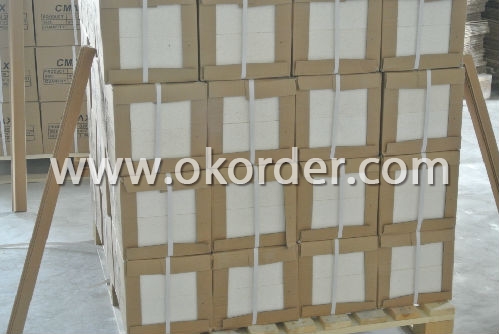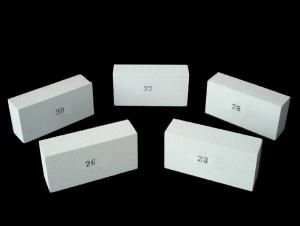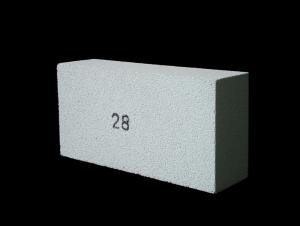Insulating Fire Brick-GJM28
- Loading Port:
- China Main Port
- Payment Terms:
- TT or L/C
- Min Order Qty:
- 1000 pcs pc
- Supply Capability:
- 1000 Tons Per Month pc/month
OKorder Service Pledge
OKorder Financial Service
You Might Also Like
General Information of Insulating Fire Brick GJM28
Insulating fire brick GJM28 are produced by high purity alumina and low iron raw materials. A viariety of shapes are available.
To make our firebricks more energy and cost effective, we have different manufacturing methods for our insulating fire bricks casting and extruding method.
For insulating fire bricks GJM28,we choose the extruding method. Extruding insulating fire bricks have better strength and offering great performance in load bearing applications and in conditions where abrasion from mechanical abuse or flow of hot gases.
Characteristics of Insulating Fire Brick GJM28
The organic fillers, which are mixed in the materials and then burned out during sintering, give our insulating fire bricks a uniform controllable pore structure. The insulating fire bricks exhibit the following characteristics:
Light weight and low thermal conductivity allows thinner furnace walls
Maintain stable structural strength throughout ambient to maximum service termperature
Low heat storage results in rapid cooling and heating operation
Low iron and impurities to enhance reducing atmosphere
High thermal shock resistance in preventing spalling
Typical Application of Insulating Fire Brick GJM28
Ceramic shuttle kilns
Metal heat treatment furnaces
Steel billet reheating furnaces
Oil refrinery heaters
Laboratory furnaces
Backup insulation for all furnaces
Technical Data of Insulating Fire Brick GJM28
|
| GJM28 |
Physical Properties: |
|
|
Classifiction Temperature | ℃ | 1500.0 |
Density | Kg/m3 | 900.0 |
Cold Crushing Strength | Mpa | 2.5 |
Reheating Linear Change(24hrs) |
|
|
1510℃ | % | 0.6 |
Hot Load Strength Deform(90 minutes) |
|
|
1320℃ at 0.069 Mpa(10psi) | % | 0.3 |
Thermal Conductivity |
|
|
400℃ | W/m.k | 0.3 |
600℃ | W/m.k | 0.3 |
800℃ | W/m.k | 0.4 |
1000℃ | W/m.k | 0.4 |
1200℃ | W/m.k | 0.4 |
Specific Heat | KJ/Kg.K | 1.1 |
Chemical Analysis: |
|
|
Al2O3 | % | 60.0 |
SiO2 | % | 38.2 |
Fe2O3 | % | 0.6 |
TiO2 | % | 0.1 |
CaO | % | 0.1 |
MgO | % | 0.1 |
Na2O+K2O | % | 0.8 |
We has success in insulating fire bricks due to their cost-effectiveness, excellent insulation properties. CNBM also has experience in insulating fire bricks application and would like to assist you in product selection, system design, and installation techniques.


- Q:Can insulating fire bricks be used in cement plants?
- Yes, insulating fire bricks can be used in cement plants. Insulating fire bricks are designed to withstand high temperatures and are commonly used in industries that require thermal insulation. In cement plants, they can be used in various applications such as lining kilns, furnaces, and other high-temperature equipment. These bricks help in reducing heat loss, improving energy efficiency, and ensuring consistent and controlled temperatures in the cement production process. Additionally, insulating fire bricks are lightweight and have low thermal conductivity, making them an ideal choice for insulating applications in cement plants.
- Q:Advantages and disadvantages of wall insulation system?
- The advantages of internal insulation: insulation walls, paint inside the wall, and direct people or other biological contact, in order to ensure human or biological health in insulation coating insulation at the same time, we must first ensure that the paint is non-toxic, no volatile substances.
- Q:Can insulating fire bricks be used in the construction of brick ovens?
- Yes, insulating fire bricks can be used in the construction of brick ovens. These bricks have high-temperature resistance and excellent insulation properties, making them suitable for retaining heat and preventing heat loss in a brick oven.
- Q:Can insulating fire bricks be used in chimneys?
- Yes, insulating fire bricks can be used in chimneys. These bricks are specifically designed to withstand high temperatures and provide excellent insulation, making them ideal for lining chimneys. They help to retain heat and prevent excessive heat transfer to the surrounding structure, enhancing the efficiency and safety of the chimney.
- Q:Do insulating fire bricks require any special fireproof gaskets or seals?
- No, insulating fire bricks do not require any special fireproof gaskets or seals. Insulating fire bricks are designed to have a high resistance to heat and can withstand high temperatures without the need for additional gaskets or seals. These bricks are typically used in applications such as kilns, furnaces, and fireplaces, where they provide insulation and help retain heat. Their composition and structure allow them to create a barrier against heat transfer, eliminating the need for any additional seals or gaskets. However, it is important to ensure proper installation and alignment of the bricks to ensure a tight fit and maximize their insulating properties.
- Q:What are the improvements and improvements during the trial production of insulating bricks?
- Insulation brick seven characteristics: insulation, heat insulation: effectively reduce energy consumption.Fire prevention: up to national standard or class A.Clean and environmental protection: no two pollution will be caused by air.
- Q:Are insulating fire bricks resistant to chemicals?
- Insulating fire bricks, in general, exhibit resistance to chemicals. They are specifically engineered to endure extreme temperatures and possess minimal thermal conductivity, making them a prime selection for chemical-related applications. These bricks are typically composed of ceramic materials, such as alumina, renowned for their exceptional chemical resistance properties. Nonetheless, it is crucial to recognize that the extent of chemical resistance can fluctuate based on the specific variant of insulating fire brick and the chemicals involved. Certain chemicals, particularly those highly corrosive or reactive in nature, may still inflict harm or deterioration on the bricks over time. Thus, seeking detailed information on the chemical resistance capabilities of specific insulating fire bricks from the manufacturer or supplier is highly recommended.
- Q:Can insulating fire bricks be used for insulation in walls or roofs?
- Insulating fire bricks are primarily designed for use in high-temperature applications, such as furnaces, kilns, and fireplaces. While they offer excellent thermal insulation properties, they may not be the best choice for insulation in walls or roofs of residential or commercial buildings. Insulating fire bricks are often made from lightweight refractory materials, such as ceramic fibers or expanded clay. These materials are highly resistant to heat, but they may not provide sufficient insulation against cold temperatures or moisture. Additionally, their structural integrity may not be suitable for load-bearing applications or other requirements specific to walls or roofs. For insulation in walls or roofs, it is generally recommended to use materials specifically designed for building insulation purposes, such as fiberglass batts, spray foam insulation, or rigid foam boards. These materials are better suited to provide both thermal and moisture resistance, as well as meet the necessary structural requirements. In summary, while insulating fire bricks may offer excellent thermal insulation properties, they are not typically recommended for use in walls or roofs. It is advisable to consult with a building professional or insulation specialist to determine the most suitable insulation materials for your specific needs.
- Q:Can insulating fire bricks be used in refractory coatings?
- Yes, insulating fire bricks can be used in refractory coatings. They provide excellent thermal insulation properties and can help in maintaining high temperatures while minimizing heat loss.
- Q:Can insulating fire bricks be used in the construction of aluminum smelting furnaces?
- Insulating fire bricks can indeed be utilized in the construction of aluminum smelting furnaces. These bricks are crafted from lightweight materials like refractory clay and possess exceptional insulating qualities. Consequently, they are well-suited for implementation in environments with elevated temperatures, such as aluminum smelting furnaces. By conserving heat and enhancing energy efficiency, they prove to be advantageous in these settings. Typically, aluminum smelting furnaces function at remarkably high temperatures, frequently exceeding 1000 degrees Celsius. In such extreme circumstances, insulating fire bricks serve as effective thermal insulation, thereby minimizing heat loss and sustaining the desired temperature inside the furnace. This insulation also contributes to reducing the energy required to heat the furnace, leading to cost savings and heightened efficiency. Furthermore, insulating fire bricks exhibit exceptional resistance to thermal shock. This quality enables them to endure rapid temperature variations without experiencing cracking or breakage. This characteristic holds significance in the context of an aluminum smelting furnace, where heating and cooling cycles can occur frequently and swiftly. In addition, insulating fire bricks possess low thermal conductivity, which is another advantage when employed in aluminum smelting furnaces. This property facilitates the retention of heat within the furnace, preventing it from dissipating into the surrounding environment. By diminishing heat loss, insulating fire bricks aid in maintaining a consistent temperature throughout the smelting process, ensuring optimal conditions for aluminum melting and refining. In summary, due to their remarkable insulating properties, resistance to thermal shock, and low thermal conductivity, insulating fire bricks constitute a suitable choice for constructing aluminum smelting furnaces. Their utilization contributes to enhanced energy efficiency, reduced heat loss, and the maintenance of a stable temperature inside the furnace.
1. Manufacturer Overview |
|
|---|---|
| Location | Jiangsu, China |
| Year Established | 2008 |
| Annual Output Value | Above US$ 35 Million |
| Main Markets | Germany; Italy; Turkey; France; England; Japan; Thailand; Vietnam; Idonesia; USA |
| Company Certifications | ISO 9001:2008 |
2. Manufacturer Certificates |
|
|---|---|
| a) Certification Name | |
| Range | |
| Reference | |
| Validity Period | |
3. Manufacturer Capability |
|
|---|---|
| a)Trade Capacity | |
| Nearest Port | Shanghai; Qingdao |
| Export Percentage | 10% |
| No.of Employees in Trade Department | 3 People |
| Language Spoken: | English; Chinese; |
| b)Factory Information | |
| Factory Size: | Twenty five thousand tons per year |
| No. of Production Lines | Above 5 |
| Contract Manufacturing | OEM Service Offered; Design Service Offered |
| Product Price Range | High; Average |
Send your message to us
Insulating Fire Brick-GJM28
- Loading Port:
- China Main Port
- Payment Terms:
- TT or L/C
- Min Order Qty:
- 1000 pcs pc
- Supply Capability:
- 1000 Tons Per Month pc/month
OKorder Service Pledge
OKorder Financial Service
Similar products
New products
Hot products
Related keywords


























